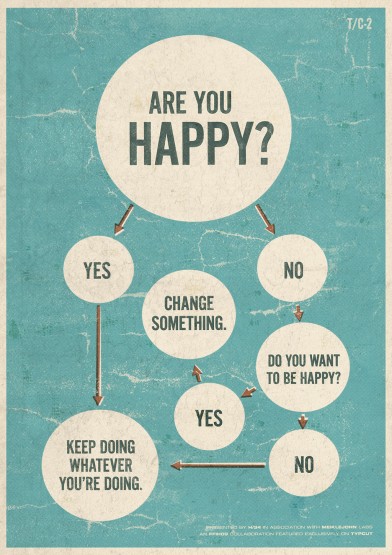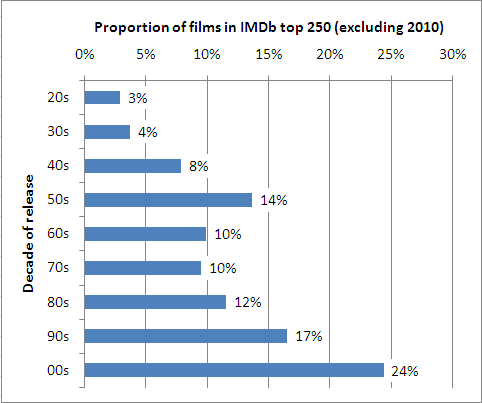Video
A beautiful demonstration of physics (or perhaps chemistry):
Quote
Scott Rudin, quoted in this GQ article about why movies are all rubbish these days:
Studios are hardwired not to bet on execution, and the terrible thing is, they’re right. Because in terms of execution, most movies disappoint.
Incidentally, while there’s clearly a huge argument to be had about the relevance of the data to the argument, let’s just contextualise the “things are terrible now” discussion by looking at the breakdown of what proportion of pre-2010 films in the IMDb top 250 come from each decade:
We see a broad trend that is the opposite of the “films used to be better” argument, apart from a post-war spike.
As I said, this is a starting point for huge arguments, and if I was going to start one I would begin with one of the following:
-Any popularity poll will tend to bias more recent candidates
-Demographic bias of IMDb voters and the scoring calculation used for the IMDb Top 250 will skew the result away from the “Objective Truth” (ha ha ha) of the matter
-This data does not speak to the more important issue of ‘typical’ film quality by decade
This week’s question
A mouse can fall any distance and survive. How is this possible?
Picture
I’ve had this obvious-but-actually-important thought myself, and this is a pretty great way of expressing it:

Answer to the previous question
In Things 94, I asked why ovens didn’t come with a built-in thermomenter.
Uncharacteristically, the Things community was unable to answer – or perhaps you weren’t interested. So I asked the internet using my secret research alter-ego* on Yahoo Answers, and also on Quora just to try that out.
You can see the range of responses I received on Yahoo answers, some of which are quite useful. The question on Quora has yet to draw a response, so I’m guessing the community there is still too niche to cover this kind of thing.
Putting together the suggestions from YA and my own thoughts, this is my conclusion:
1) It’s difficult (and therefore expensive) to make an oven thermometer that will remain accurate for the device’s lifetime. If it wasn’t, I suspect ovens would be thermostat-based, and we wouldn’t have the problem to begin with. (As I said, baking books insist there is a problem, and anecdotally I can report my gas oven is almost two gas marks cooler than it should be, and adjusting for this significantly improved my baking results).
2) It also must be difficult (and therefore expensive) to design and calibrate an oven such that it accurately produces the intended temperatures throughout its lifetime, because (once again) if this wasn’t true the problem wouldn’t arise.
3) The solution to the problem is to have a separate thermometer and use it from time to time to calibrate your oven. That thermometer then doesn’t need to maintain integrity for every use of your oven, and even if it does break it’s much easier to replace than an integrated one would be.
4) Admitting there is even a problem looks bad, so any oven manufacturer supplying such a thermometer unit with its devices would be perceived as worse than those that pretend there isn’t a problem.
5) Even if a manufacturer did include a built-in thermometer, people unaware of the oven temperature problem would again presume the oven must be sub-standard to need one, and people that know enough to worry would realise an integral thermometer couldn’t be trusted for long.
I suspect similar principles apply to protective cases and screen protectors for mobile devices.
*A long time ago I thought it might be prudent to separate my question-asking online identity from my confident-and-opinionated online identity. This doesn’t seem quite as important any more, and now that Things is a blog it’s very easy for someone to connect the two anyway, so now I don’t worry about linking from one to the other. But I’ll still use it anyway.
